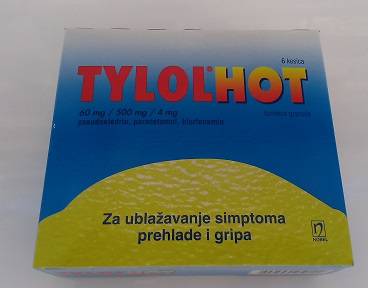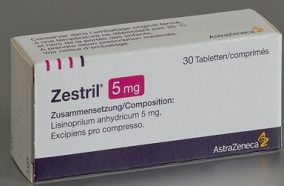Contents
What does Zestril do in the body?
Absorption: Zestril absorption is about 25%. However, studies showed that it is widely variable between individuals (6 to 60%). Zestril has a small bioavailability of 25%. Time of maximum concentration in blood is about 7 hours. Absorption is unaffected by food.
Distribution: In blood, lisinopril does not bind to proteins.This drug does not distribute as well in people with NYHA Class II-IV heart failure.
Metabolism: Zestril doe not undergo metabolism, it is unchanged excreted in urine.
Elimination: Lisinopril is eliminated from the body completely unchanged in the urine. The half-life is 12 hours. This is increased in people with kidney problems.
What does Tylenol do in the body?
Tylenol is a Brand name for a drug that contains acetaminophen (also known as paracetamol) as main ingredient. It has has antypiretic and analgesic properties.
Other active ingredients that different Tylenol products can have are: dextromethorphan, cough supressant, phenylephrine, nasal decongestive, chlorpheniramine, antihistamine, codeine, antitussive and pseudoephedrine also nasal decongestive.
It is used for reducing pain and fever and also for relieving the symptoms of common cold, cough, headache, toothache, allergies and influenza. Usual per oral doses for Tylenol are 325-650 mg. It is available in following dosages forms: tablets, caplets and liquid dosage forms.
Absorption: Acetaminophen absorption after oral administration is rapid and almost complete in gastrointestinal tract.
Distribution: Acetaminophen’s volume of distribution is about 50 L. The concentration in serum are usually below 30 µg/ml after oral administration. After 4 hours the concentrations in blood are usually 10 µg/mL. Its protein binding percentage is about 25%.
Metabolism: Acetaminophen is primarily metabolized in the liver in following metabolic pathways: glucuronidation, sulfate conjugation and N-hydroxylation, dehydration with GSH conjugation. The hepatic isoenzyme cytochrome P450 metabolises acetaminophen forming metabolite known as NAPQI, product which is primarily responsible for the toxic effects of this drug. At recommendable doses of acetaminophen, NAPQI is detoxified with glutathione conjugation. However at higher doses (>4 g), NAPQI can cause serious liver side effects.
Elimination: About 80% of acetaminophen is excreted in the urine and about 3% is excreted unchanged. Acetaminophen half-life is 1-4 hours.

How does Zestril and Tylenol work in the body?
Lisinopril is a potent ACE inhibitor drug that antagonizes the effect of the renin–angiotensin–aldosterone system – RAAS, by blocking the actions of angiotensin converting enzyme (ACE) keeping Angiotensin I from being converted to Angiotensin II.
The inhibition of RAAS system causes an overall decrease in blood pressure. The RAAS system is a homeostatic mechanism that regulates the balance of hemodynamics, water and electrolytes.
When renal blood pressure or blood flow is reduced or during sympathetic stimulation, granular cells of the juxtaglomerular apparatus in the kidneys release renin.
In the blood, renin converts circulating inactive angiotensinogen to angiotensin I – ATI, which is subsequently degraded to angiotensin II – ATII by angiotensin converting enzyme – ACE. ATII can increase blood pressure using many mechanisms.
ACE is also involved in the bradykinin enzymatic deactivation, which is known vasodilator. By inhibiting the deactivation of bradykinin, increased bradykinin levels can sustain further the effects of lisinopril by causing increased vasodilation and decreased blood pressure.
Elevated bradykinin level after ACE inhibitor administration can cause: dry cough, and inflammation-related pain, angioedema, rash and hypotension.
Acetaminophen is highly selective COX-2 inhibitor that inhibits prostaglandin synthesis. It can inhibit COX-2 in CNS. Acetaminophen also acts on the hypothalamic heat regulating centers to produce antipyresis.
Acetaminophen’s reactive metabolite N-acetyl-p-benzoquinone imine (NAPQI) can cause a potentially fatal, hepatic necrosis through the process of lipid peroxidation if acetaminophen is overdosed (more than 4g daily).
Can patients take Zestril and Tylenol together?
Patients should talk with their doctor first before using Zestril together with Tylenol. Combination of these drugs is generally safe because there is no interactions, however patients with liver diseases and impaired liver function should avoid this combination.
Patients may feel sleepier if they are taking Tylenol PM while taking Zestril, simply because one of the reported side effects of Zestril is drowsiness. If patient is going to sleep anyway, this shouldn’t be a problem.
The table below shows the incidence of side effects after Zestril and Tylenol administration in recommendable doses. The incidence can be increased if these drugs are taken together or overdosed.
| Very common side effects >10% | Dizziness (5-12%) |
| Common side effects 1-10% | Cough (4-9%), Headache (4-6%), Diarrhea (3-4%), Hyperkalemia (2-5%), Chest pain (3%), Fatigue (3%), Hypotension (1-4%), Nausea/vomiting (2%), Kidney disease in patients with AIM (2%), Rash (1-2%) |
| Rare side effects <1% | Psoriasis, Angioedema, Immune hypersensitivity reaction, Acute renal failure, Atrial fibrillation, Hypersomnia, Bone marrow suppression, Anuria, Arthralgia, Alopecia, Pancreatitis, Cutaneous pseudolymphoma, Atrial tachycardia, Mood changes, Skin infections, LeukopeniaSkin infections, Leukopenia |
| Frequency not defined | Angioedema, Dizziness, Disorientation, Pruritic maculopapular rash, Hyperammonemia, Rash, Toxic epidermal necrolysis, Stevens-Johnson syndrome, Gastrointestinal hemorrhage, Urticaria, Agranulocytosis, Leukopenia, Neutropenia, Laryngeal edema, Pancytopenia, Thrombocytopenic purpura, Thrombocytopenia, Hepatotoxicity, Nephrotoxicity Pneumonitis, Liver failure, Anaphylactoid |
Special precautions and warnings during Zestril and Tylenol administration:
- Patients using Zestril should tell their doctor and pharmacist if they are allergic to lisinopril or any other ACEI drugs such as: captopril (Capoten), fosinopril (Monopril), enalapril (Vasotec, in Vaseretic), perindopril (Aceon), quinapril (Accupril, in Accuretic, in Quinaretic), benazepril (Lotensin, in Lotrel), moexipril (Univasc, in Uniretic), ramipril (Altace), and trandolapril (Mavik, in Tarka) or any other medications or any of ingredients in Zstril tablets.
- Patients using Zestril should tell their doctor if they have diabetes and if they are taking drug aliskiren (in Amturnide, Tekturna, Tekamlo, Tekturna HCT). Doctor will probably tell not to take lisinopril if patients have diabetes and if they are also taking aliskiren.
- Patients on Zestril therapy should also tell their doctor and pharmacist what prescription and nonprescription medicines, nutritional supplements, vitamins, and herbal products they are taking. They should mention if they are using any of the following drugs: aspirin and indomethacin (Indocin, Tivorbex), diuretics, lithium (Lithobid) and potassium supplements. Doctor may need to change the doses of these medications or monitor carefully for side effects.
- Patients using Zestril should mention their doctor if they have or have ever had some heart or kidney disease, diabetes, lupus or scleroderma.
- If patients are having surgery, including dental surgery, they should tell doctor or dentist that they are taking lisinopril.
- It is important to know know that diarrhea, vomiting, or any cause of dehydration can cause a drop in blood pressure, causing lightheadedness and fainting.
- Patients should tell their doctor if they have or have ever had any of following conditions such as: asthma, frequent stuffed or runny nose or nasal polyps, swelling of the inside of the nose, swelling of the arms, feet, ankles, hands, or lower legs; lupus or liver or kidney disease.
- Patients should tell their doctor if they have ever had a rash while taking acetaminophen.
- Patients with phenylketonuria should avoid these medicines.
- Patients should also know that combination acetaminophen products for cough and colds containing cough suppressants expectorants, nasal decongestants and antihistamines, should not be used in children younger than 2 years of age. In children 2 through 11 years of age such combinations should be used carefully and only according to the directions on the label.
- Patients should avoid alcohol while using these medications. Drinking alcohol can increase certain side effects of these medications. Alcohol may increase the risk of liver damage while taking Tylenol.
- Tylenol can cause unusual results with certain laboratory tests for glucose in the urine.
- Patients should avoid becoming dehydrated or overheated during exercises. Chlorpheniramine can decrease sweating and patients could become more prone to heat stroke
- Patients should avoid these medications if they also take caffeine pills, diet pills, or other stimulants. Taking decongestants (pseudoefedrine, phenylephrine) together with stimulants can increase the risk of unpleasant side effects.
“Can I take levothyroxine and citalopram together?“
“Can you drink alcohol while taking zyrtec d?“

